Courtesy of the Seattle Art Museum

The Drifter, 1964, Andrew Wyeth, American, 1917-2009, drybrush watercolor on paper, 22 ½ x 28 ½ in., Collection of Phyllis and Jamie Wyeth, ã 2017 Andrew Wyeth / Artist Rights Society (ARS)
As I laid awake on Saturday night, harassed by pangs of homesickness, I reminded myself that the next morning, I would be going to see Andrew Wyeth’s paintings on display at the Seattle Art Museum. This was an important thought—for as long as I can remember, Andrew Wyeth’s visual art has represented in great detail the subtly charming and picturesque landscapes of Southeastern Pennsylvania that I proudly hail from. So yes, reassuring myself that tomorrow would bring these familiar sights did, in fact, help me sleep.
The exhibit is called “Andrew Wyeth: In Retrospect,” and is laid out more or less chronologically: The first paintings on display come earlier, and the last come at the end. It is a visual auto-biography, so to speak, depicting Wyeth’s happiness, tragedy, inevitable acceptance of that tragedy, and finally of an oncoming death. To understand Wyeth’s art, one must understand Wyeth’s legend.
He was born in 1917, the son of renowned and celebrated illustrator N.C. Wyeth. N.C. was most famous for illustrating, and bringing life to the swashbuckling novel, Treasure Island. His depictions of the characters Long John Silver, Captain Flint, and Billy Bones were a major step in the adaptation of the modern image of pirates (the “argh matey” kind, not the Tom Hanks’ movie kind). N.C. was Andrew’s teacher, and Andrew quickly developed incredible skills with a watercolor paintbrush. The early paintings in the SAM exhibit are representative of how brilliant his early work is: the colors that he uses are so bright and plentiful that they seem to pop out of the frame. The paintings’ primary function seem to be for the purpose of creating something pleasing to the eye, and under N.C. Wyeth’s guidance, Andrew accomplishes this with (pun intended) flying colors (I had to do it).
However, when walking into the center of the exhibit, you notice that the colors drastically and quickly die down, like they are fossils in a Permian-Triassic Boundary outcrop. Something happens here. Something changes the mood of Wyeth’s paintings so radically that it is impossible not to recognize it as tragedy.
In October 1945, N.C. Wyeth and his three-year-old grandson Newell Convers Wyeth (Andrew’s nephew) were in a car that stalled on train tracks, and they both left Andrew’s world. So did the brilliant red tones of Andrew’s innocence, the bright green tones of his eagerness and bliss, the dark full blue skies of his youth, and fertile browns of his new Earth. All of these colors condensed when his father and his nephew were killed, condensed into the frozen wastelands that were now presented to him as reality. Winter 1946 is a piece with the subject of a lost boy stumbling his way down a hill in this beautiful, grey-green wasteland. The confusion on his face has not yet changed into hopelessness, but anyone can tell he is need of help. He’s searching for the brilliant colors that once encapsulated his world. The fallen crow in his 1942 piece Winter Fields is even more obvious.

Winter 1946, 1946, Andrew Wyeth, American, 1917-2009, tempera on hardboard panel, 31 ⅜ x 48 in., North Carolina Museum of Art, Raleigh, Purchased with funds from the State of North Carolina, ã 2017 Andrew Wyeth / Artists Rights Society (ARS).
Accepting the reality of this new Earth was a major step in Wyeth’s career. As you walk further into the exhibit, you begin to see more and more detail in his subjects’ facial features. The detail becomes so tremendous that these people come to life. They are saying something through the way they are looking, although the frame that surrounds their environment forever silences them. Braids is one of these paintings: It is one work within Wyeth’s controversial “Helga” series. Wyeth completed the Helgas in secret- both from his wife and from Helga’s husband. Braids in particular shows the level of intimacy the two had—more so than any of the paintings in which Helga is naked. Her gaze downward suggests her guilt of what she and Wyeth are doing, but her eyebrows suggest a heavy contemplation of whether or not that guilt is necessary. Other than her physical appearance, there is nothing else in the picture that the viewer can analyze of interpret. The background is a solid black color, with no other objects present because Wyeth wants 100% of the focus on Helga.
As he aged, his paintings gradually began to revolve around the concept of death. In 1978, Wyeth published his piece Spring, depicting a dying man melting along with the winter snow. This is one of my favorite Wyeth pieces of all time because it masterfully implements heavy symbolism of what Wyeth is thinking about. The scene is still set in the green-yellow landscape that had been plaguing him since his father’s death; the same landscape that the boy of Winter 1946 was so hopelessly lost in. Yet, the viewer can tell that something is changing. Once the man is melted, it seems that some of the colors might come back. Winter could finally be passing.
Altogether, Andrew Wyeth’s paintings are exceptionally special to me—they possess the capability to relieve my homesickness, and they remind me of the subtle beauty that any wasteland can carry. I went to bed on Sunday night satisfied with those landscapes I was able to remember. Wyeth’s art is alive, and I encourage anyone who is interested to go and see his exhibit.
JASON MCCUE | Why Y Wyeth | KXSU Promotions Director

